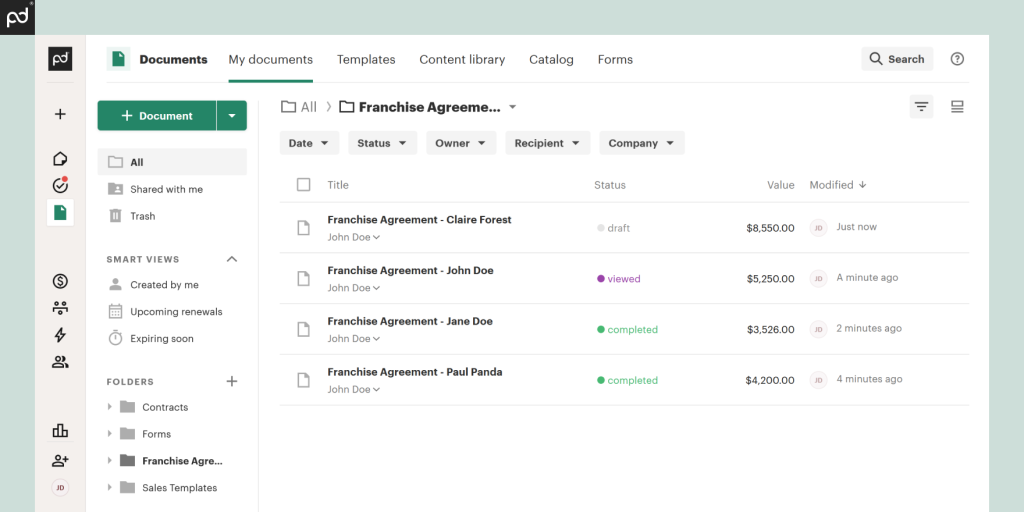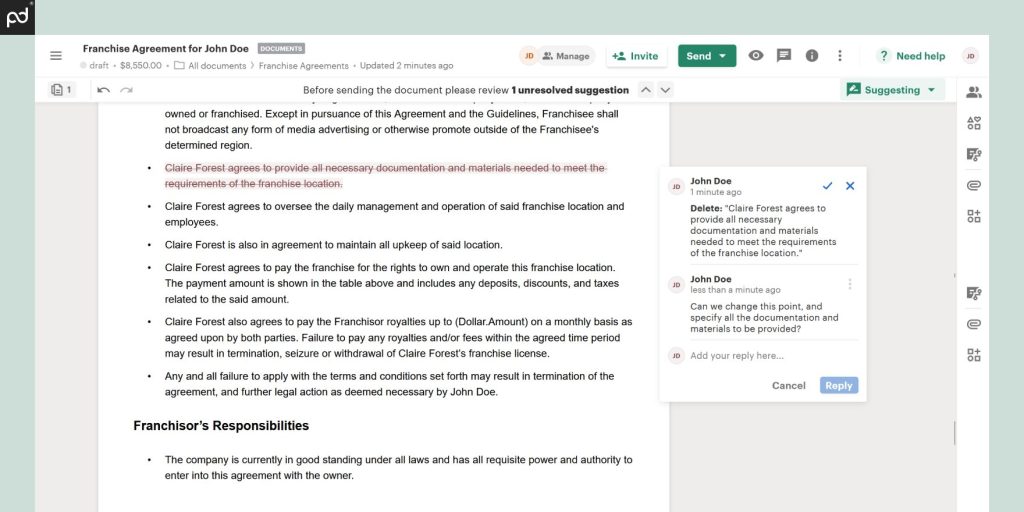Many businesses expand their locations through franchising. Before this can happen, a franchise agreement needs to be in place.
This is a legal document that outlines the rights and responsibilities of both the franchisor and the franchisee.
Understanding what a franchise agreement includes and knowing when to use a typical franchise agreement can help protect your business operations and ensure a smooth franchising process.
PandaDoc streamlines the creation of franchise agreements with customizable templates, ensuring all necessary legal elements are included and easily understood.
First things first. You need to know what to include in a franchise agreement and the what makes it an indispensable part of the franchise system.
This can help you maintain your business relationships, understand franchise opportunities, non-competes, and provide additional information to ensure quality control.
What is a franchise agreement?
A franchise agreement is a legally binding contract between a franchisor and a franchisee.
This document grants the franchisee the right to operate a business using the franchisor’s brand, business model, and intellectual property. In exchange, the franchisee typically pays an initial franchise fee and ongoing royalties.
There are four common sub-categories of franchise agreements.
- Single-unit franchise agreement: As the name suggests, this type of franchise agreement allows the franchisee to own and operate a single unit.
- Multi-Unit franchise agreement: This type of franchise agreement is used when a franchisee wants to own and operate multiple units. This can also expand across multiple cities and states, depending on the agreement with the franchisor.
- Area development franchise agreement: This is more of a long-term agreement that grants the franchisee the right to open multiple locations within an agreed upon period of time. This can also grant the franchisee exclusivity with a certain location or location(s).
- Master franchise agreement: This type of agreement is a combination of the multi-unit and area development agreements, with the added bonus of allowing the franchisee to sell their units to other people as well.
The terms of the franchise agreement sets the foundation for the franchise relationship, detailing the conditions under which the franchisee can operate. This is also known as the franchisee’s obligations.
For example, say you want to open a McDonald’s restaurant.
A sample of their franchise disclosure agreement is available online.
This document discloses that a typical initial franchise fee with the restaurant chain is $45,000.
More specifics will change depending on the laws in the state in which a franchisee intends to operate.
It’s important for both parties to understand their obligations and the expectations of state laws under the franchise agreement.
Common uses for a franchise agreement
Business expansion
Franchisors use franchise agreements to expand their footprint across different locations with no need to personally manage each branch.
This allows businesses to grow at a faster pace by leveraging the investment and help of franchise business through territory rights.
Standardization and consistency
Franchise agreements ensure that all franchisees adhere to specific franchise operation standards and use the franchisor’s trademarks and systems.
This consistency helps maintain the brand’s reputation and customer experience across all locations.
Protection of intellectual property
These agreements protect the franchisor’s intellectual property by defining the rights and limitations of its use by franchisees.
This legal protection helps prevent unauthorized copying of the brand’s proprietary elements by laying out disclaimers upfront along with any ongoing fees, right of first refusal, and royalty payments under franchise rules.
With PandaDoc, franchisors can securely store and manage all franchise agreements in one place, making it simple to track and update documents as needed.

Main industries utilizing franchise agreements
Food and beverage
Fast food chains, coffee shops, and restaurants are some of the most common businesses that use franchise agreements for expansion to new franchise ownership.
This is why you’ll often see the same restaurants no matter where you go across the country, sometimes even globally.
Retail
Many retail businesses, including convenience stores, clothing, and specialty shops, utilize franchise agreements to scale their business operations.
This can be shope you frequently see in malls, and even mini-marts such as 7-11.
Health and fitness
Large-scale and boutique gyms often expand through new franchise locations.
This can be an integral part of their business model when appealing to new members.
For example, a gym may offer a discounted rate for one location, or an all-encompassing membership to allow those who travel access to their same gym anywhere they operate.
Hospitality and lodging
Hotels and motels frequently use franchise agreements to manage properties.
This helps them make their brand easy and convenient to people who enjoy their accommodations.
Hilton is a great example of a top-tier hotel chain that has locations worldwide and offers Hilton Rewards to members.
With PandaDoc, franchisors can streamline the negotiation and approval process, making it easier to establish and enforce financial terms while protecting their intellectual property rights.

What to include in a franchise agreement
To draft your franchise agreement, no matter the type, a few important elemnts must be included.
This will help ensure clarity, protect the franchisor’s intellectual property, and outline the franchisee’s rights and responsibilities.
1. Intellectual property rights
One of the most important parts of a franchise agreement is the delineation of intellectual property rights.
This section goes in depth about the various forms of intellectual property that the franchisor grants the franchisee the right to use.
This includes trademarks, logos, proprietary systems, copyrights, patents, and more.
Clearly stating these rights helps to maintain brand integrity and provides legal protection against misuse.
Trademarks and logos
The franchise agreement should specify the rights related to the use of the franchisor’s trademarks and logos, as they are vital to the brand’s identity and reputation.
Any misuse or unauthorized alteration constitutes legal liability.
Proprietary systems
This may include items such as business models, operational guidelines, and customer service protocols.
The franchisee is given training and access to this knowledge under specified guidelines to maintain a uniform customer experience and operational efficiency across locations.
Trade secrets
The agreement must include clauses that clearly state for the franchisee to keep the confidentiality of trade secrets, both during and after the term of the franchise agreement.
This protection helps safeguard the franchisor’s proprietary knowledge from competitors and unauthorized disclosure.
Patents
This includes specifying whether the use is exclusive or non-exclusive, in addition to clarifying any royalties or fees associated with the use of patented technology.
Infringement of these patents can result in legal repercussions for the franchisee.
Copyrights
The franchise agreement should outline the permissible use of copyrighted materials by the franchisee, including restrictions on copying, distributing, or altering the content.
This is to make sure that the use of materials are consistent and compliant.
Limitations and enforcement
This includes the prohibition of using the intellectual property beyond what’s detailed in franchise agreement, such as for unauthorized personal projects or outside business ventures.
2. Initial franchise fee and ongoing royalties
This can include the initial franchise fee and royalties.
The initial franchise fee is a one-time payment made by the franchisee to the franchisor for the rights to operate and open a location or locations agreed upon under the business.
Ongoing royalties are typically based on a percentage of the franchisee’s revenue or may be offered to the franchisee in a fixed amount.
A payment schedule needs to be detailed in this section for transparency and to help avoid disputes in the future.
3. Franchisee and franchisor responsibilities
For the franchisee, this includes operational standards, marketing requirements, training programs, and adherence to the franchise system.
For the franchisor, this includes providing initial training, ongoing support, marketing assistance, and ensuring the franchisee sticks to the brand’s standards.
This section is vital in helping manage expectations within the franchise relationships.

4. Exclusive rights and territory
This section specifies the geographic area in which the franchisee has the exclusive right to operate, preventing the franchisor from opening additional franchises within that area.
Exclusive rights are essential for protecting the franchisee’s investment to help prevent the risk of market saturation.
5. Dispute resolution and arbitration
Arbitration is a method of resolving disputes outside the court system, often seen as a quicker and more cost-effective solution should this be needed.
By including a dispute resolution clause, both parties agree to a specified method for handling conflicts, which can help maintain a positive working relationship and reduce litigation costs.
PandaDoc for all your franchise agreement needs
A legally sound franchise agreement is necessary for any successful franchising relationship.
It protects the franchisor’s intellectual property, clearly details financial terms, territories, responsibilities, and methods for conflict resolution should it be needed.
Knowing what type of franchise agreement to use, what to include, and when it’s needed, helps franchisors and franchisees have a clear and legally binding partnership.
PandaDoc makes the creation, signing, and execution of franchise agreements easy by saving you time.
You can create and send franchise agreements easily using our template creation tool, and tailor it to your business’s needs.
PandaDoc provides real-time tracking and notifications, so franchisors can monitor the status of document signings.
By using PandaDoc, franchisors can easily collaborate and communicate with franchisees.
Request a demo today to see how PandaDoc can streamline your franchise agreement processes.
Disclaimer
PandaDoc is not a law firm, or a substitute for an attorney or law firm. This page is not intended to and does not provide legal advice. Should you have legal questions on the validity of e-signatures or digital signatures and the enforceability thereof, please consult with an attorney or law firm. Use of PandaDoc services are governed by our Terms of Use and Privacy Policy.


